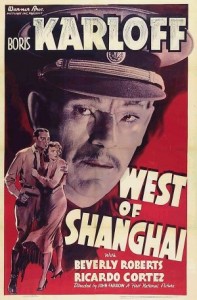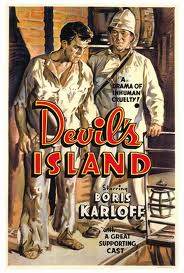Most folks identify [intlink id=”1558″ type=”category”]Boris Karloff[/intlink] with his widely known horror films, and rightfully so. However, Karloff was an actor with a bit more range than most are aware of. Granted most of these are in slightly less well known pictures, but we have looked at two of them- namely John Ford’s [intlink id=”11203″ type=”post”]The Lost Patrol[/intlink] and 1939’s [intlink id=”8740″ type=”post”]Devil’s Island[/intlink]. Great pictures they are not, but they show another side to one of the better actors of history.
The Warner Archive, in their great wisdom, has just released a new three feature set, including West of Shanghai, The Invisible Menace, and Devil’s Island. Filmed from 1937 to 1939, none are true feature films in the current sence of the word, with none running more than 70 minutes. Combined they provide a good mix of mystery and suspense and none would qualify as horror.
Devil’s Island (1939) is the strongest of the three, though some would differ and claim that honor go to the earlier 1937 film West of Shanghai. Most would agree that The Invisible Menace is by far the weakest of the lost, being rather tepid with Karloff missing here from the action for good chunks of the picture.
In Devil’s Island Karloff is Dr. Charles Gaudet, a man caught between his philosophy as a surgeon and the law. The film has a grander feel than the other two and sports, in spite of the short run time, some fairly impressive production values from Warner Brothers.
 West of Shanghai features Karloff as an Asian warlord hold a slew of American hostages. Perhaps the only weaknesss of this picture are the slightly light production values and the sheer amount of action and plot changes which are crammed into such a short film.
West of Shanghai features Karloff as an Asian warlord hold a slew of American hostages. Perhaps the only weaknesss of this picture are the slightly light production values and the sheer amount of action and plot changes which are crammed into such a short film.
None of these pictures were intended as big events and were released as part of a double-bill. The passing Karloff fan or one looking for a good representative introduction to the man’s career should probably look elsewhere, as these are not his best nor his biggest pictures. However, for the serious fan who wants a more complete picture of Karloff’s career these are of definite interest. For these folks it almost merits a must have recommendation.
As usual with Warner Archives releases, there are no supplemental materials and only minimal work has been done on the source elements, although all are in rather good shape and are very watchable, all things condsidered.
Thanks to Warner Brothers for the review copy provided.
